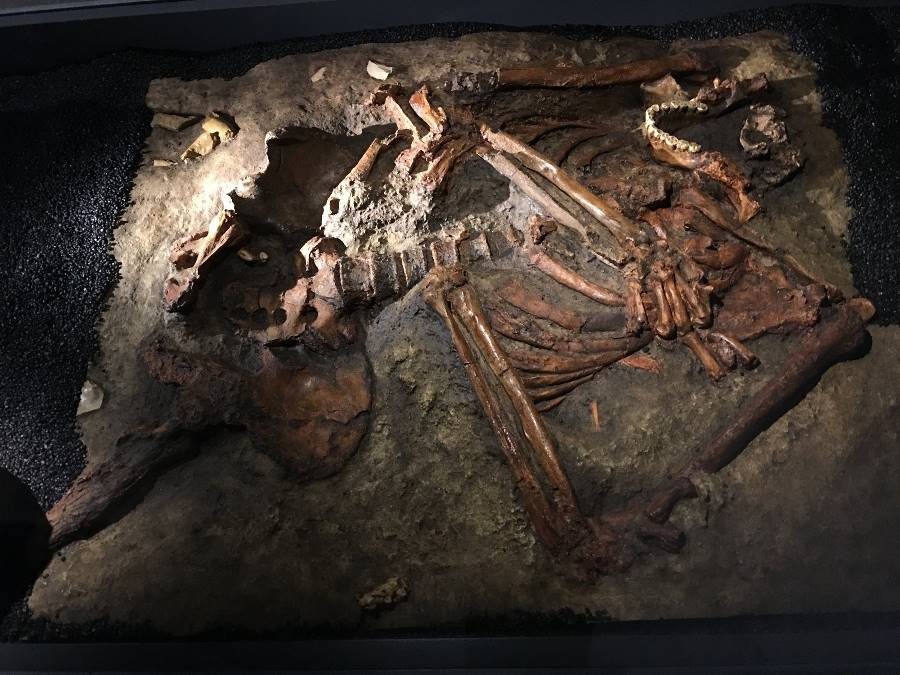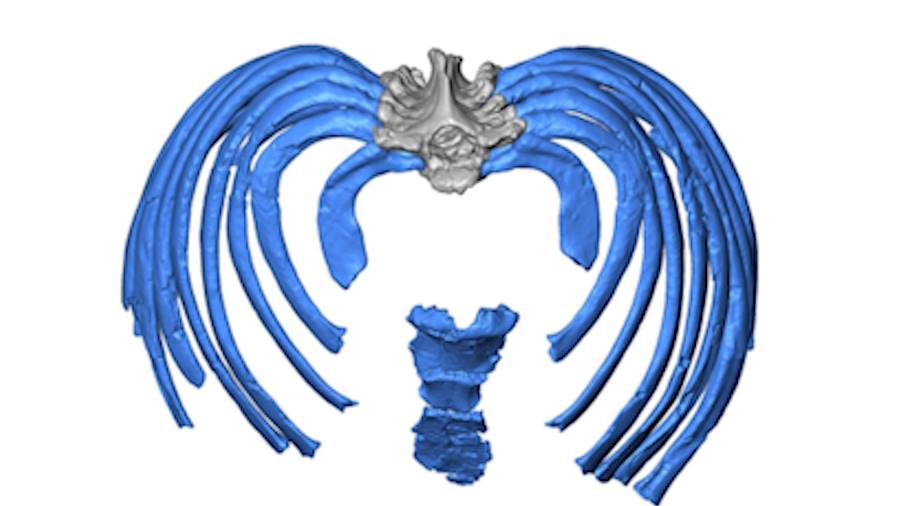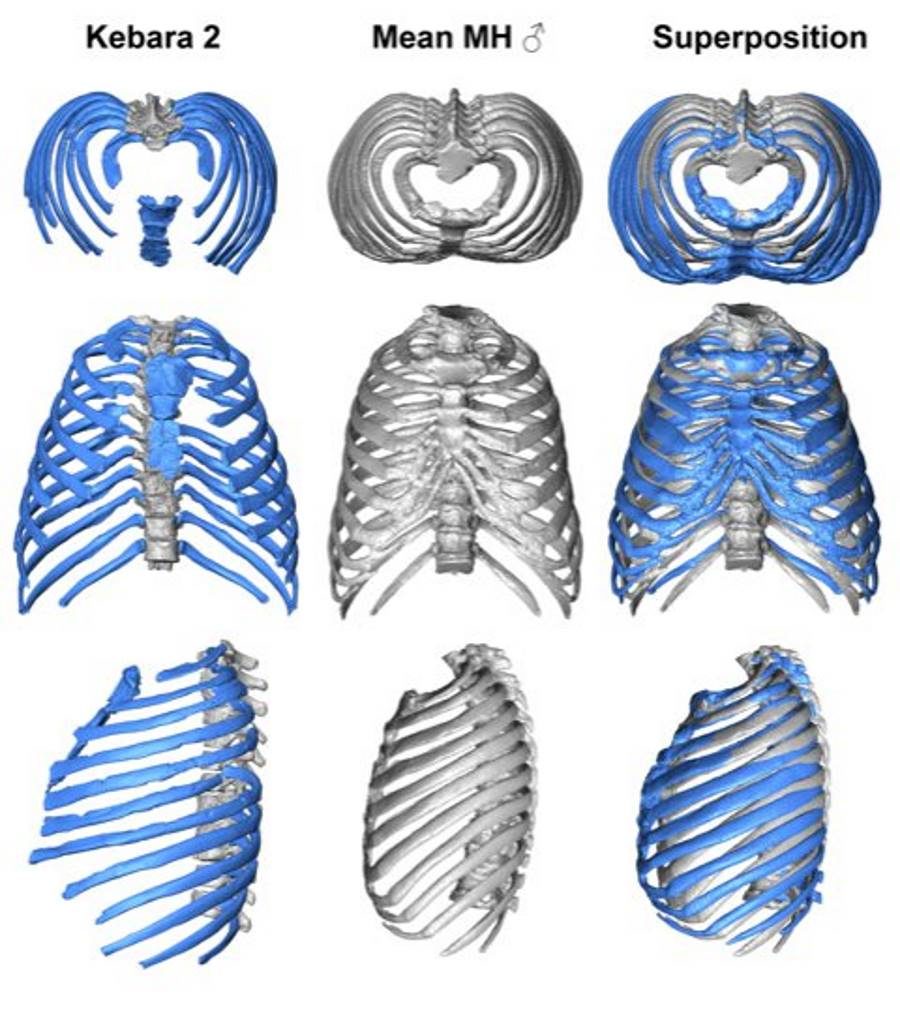
We are not Neanderthals. At the same time, we're not all that different. Like our own Homo sapiens ancestors, Neanderthals made use of stone tools and fire. They may have buried their dead and cared for the sick. Neanderthals even mingled their DNA with ours. For many, these sexual encounters paint an odd portrait of a union between our Homo sapiens predecessors and their stooped, brutish caveman rivals. But more and more, it's becoming clear that our conception of Neanderthals needs a reboot: they're much closer to us than we once believed.
Today, a new discovery further blurs the boundaries between us modern humans and these people of the past. With the first 3D virtual reconstruction of the Neanderthal rib cage, an international team of scientists shows these archaic humans not only stood upright, but also may have breathed and moved in ways that differed only subtly from modern humans.
The finding, published in Nature Communications, is borne out of a joint effort between researchers from the United States, Spain, and Israel, and helps fill a longstanding gap in our understanding of Neanderthal anatomy-particularly, the build of the thorax, which is composed of the rib cage and upper spine, and would have greatly affected the way Neanderthals interacted with their environment.
Neanderthals first appeared at least 450,000 years ago in Western Europe. When their lineage went extinct about 400,000 years later, it left behind only a sparse record of their existence. The few hundred Neanderthal skeletons excavated in the nearly 200 years since their initial discovery are all incomplete. Delicate bones like ribs and vertebrae preserve especially poorly in the fossil record, and the scarcity of definitive evidence has fueled controversy over how similar or different their anatomy was compared to our own.
Their strong, stocky builds previously led some to theorize Neanderthals had a much larger lung capacity than modern humans - something that might have helped them weather their strenuous hunter-gatherer lifestyle in cold climates. But the lack of clear fossil evidence has left the debate about the Neanderthal thorax unresolved, warranting a new approach to interpreting our distant ancestors.
"It's imperative to understand the limited amount of information with which paleoanthropologists often work," says Kristin Krueger-Vinson, a biological anthropologist at Loyola University Chicago who was not involved in the new find. "It's similar to solving a 1,000-piece puzzle with only, say, 250 random pieces."

When the team compared their reconstruction to the medical scans from 16 modern adult men in Israel, the similarities in the overall structure were immediately apparent. However, there were a few small differences. For one thing, Kebara 2's lower rib cage was a bit wider, left-to-right, and deeper, front-to-back, compared to the present-day scans, contributing to a slight bell shape. In modern humans, the thoracic structure tapers slightly more at the bottom.
At the same time, however, the shorter Neanderthal stature somewhat compressed the height of the rib cage-meaning that all in all, the size of the thorax was pretty much the same in Neanderthals and modern humans.
For Kramer, however, the biggest surprise was how Kebara 2's ribs met his spine. Compared to those of modern Homo sapiens, this Neanderthal's ribs bowed out a bit more in the back-meaning they had to curve inwards to meet the spine, giving the rib cage a B-shaped appearance when seen from above. With the spine pushed deeper into the thorax, Neanderthals may have enjoyed a more stable posture. In keeping with this, a previous 3D reconstruction from the same research team had pointed to Neanderthals sporting a straighter spine than modern humans, with little of the characteristic lumbar curve that indents our lower back.
[3-D manipulatable model here. Allow time to load.]
"A straight column to load the lower body makes a lot of sense," study author Patricia Kramer, an anthropologist at the University of Washington, says. "[Homo sapiens] didn't evolve that... and we have lots of problems today because of it, like low back pain. Maybe the Neanderthal line evolved a better evolutionary solution."
In the future, Kramer and her colleagues hope to expand on their findings and their implications for Neanderthal physiology-how they breathed, how they walked, how they braved frigid temperatures.
"We've only begun to ponder what that means for internal organs, now that we have the container," Kramer explains.

When modern humans inhale, we rely on both the downward pull of our diaphragm and the ballooning of the muscles in the upper rib cage. If Kebara 2's reconstruction holds true, however, his more expansive lower rib cage may indicate that Neanderthal breathing relied more on the drop of the diaphragm. As Steven Churchill, a Neanderthal expert and evolutionary anthropologist at Duke University who did not participate in the research, explains, with such downward flexibility, Neanderthal lungs could still have us beat in terms of volume, even with a similarly sized thorax - a bit like tugging down on the bottom of a birdcage. Bones alone can be cryptic, however: Without actual lungs or a diaphragm, it's hard to say how these tissues made the most of the space they were given.
What's more, individuals like Kebara 2 aren't always representative of their entire lineage, explains Blaine Maley, an anthropologist at the Idaho College of Osteopathic Medicine who, with colleagues, independently generated the first synthetic reconstruction of the Neanderthal skeleton in 2005. "You have to ask that question: Is this consistent with other Neanderthals at this time, in that area?" Maley says. "It's always possible this individual is outside the range of its population."
For instance, Neanderthal expert and paleoanthropologist Erik Trinkaus of Washington University in St. Louis points out that Kebara 2's right ribs exhibit what have been theorized to be some small genetic anomalies. Additionally, Trinkaus notes, Kebara 2 sported a particularly wide pelvis that may not be representative of all Neanderthals. It's possible these deviations could have altered Kebara 2's spine, which also suffered from a very mild form of scoliosis.
However, Carol Ward, an anthropologist at the University of Missouri's School of Medicine who did not participate in the research, points out that "even if you look at modern humans, everybody's spine is a little bit variable - we all have oddities and asymmetries."
Taken as a whole, Kebara 2's stature probably isn't terribly deviant from his kin - or, really, from us. And, for now, this skeleton is the most complete thoracic specimen researchers have - piecing together a reconstruction from any other individual would have involved far more approximation.
What we're not lacking, however, are modern human skeletons. Kebara 2 didn't measure up perfectly to the 16 Israeli men against whom he was compared - but the differences may grow or shrink depending on the population in question. Expanding the modern comparative sample to encompass more diversity and variation in body types around the globe may have enhanced their findings, explains Krueger-Vinson.
Although Kebara 2 once inhabited what is now Israel, his experience of the world was by no means equivalent. Bringing in the physiology of modern humans who live in cold climates and high altitudes - who, according to Ward, have larger lung volumes, among other adaptive traits - could even yield insight into how Kebara 2 and his relatives survived the extremes of their time. In solving the puzzle of Neanderthal anatomy, modern humans may yet be some of the best points of reference.
If Neanderthals were still alive today, you might be able to pick them out of a crowd - but not easily. "You might do a double take," Kramer explains. "But there's an awful lot of variation out there."



Does it Mean to be Human
[Link]
Neanderthal 1 was the first specimen to be recognized as an early human fossil. When it was discovered in 1856 in Germany, scientists had never seen a specimen like it: the oval shaped skull with a low, receding forehead and distinct browridges, the thick, strong bones. In 1864, it became the first fossil hominin species to be named. Geologist William King suggested the name Homo neanderthalensis (Johanson and Edgar, 2006), after these fossils found in the Feldhofer Cave of the Neander Valley in Germany ( tal —a modern form of thal —means “valley” in German). Several years after Neanderthal 1 was discovered, scientists realized that prior fossil discoveries—in 1829 at Engis, Belgium, and in 1848 at Forbes Quarry, Gibraltar—were also Neanderthals. Even though they weren’t recognized at the time, these two earlier discoveries were actually the first early human fossils ever found.
And this is the foundation of the modern "myth" of Neanderthals, a few bone fragments found in the Neander valley in Germany, no forensic analysis, no real archaeological studies, no anthropological studies, pure speculation, assumption and conjecture, guess, that was the thing in 1856. They were "gentlemen" and their word could not be questioned.
All these fragments of bones that are attributed to Neanderthals, could they be nothing more than ape species that have never been recognized, the rib cages certainly have the appearance of say a gorilla, or could they belong to another species of human that was far more robust than we are familiar with today.
The most disturbing thing of all for me is that the "myth" of the Neanderthals all started in the Neader valley in 1856. As for the find in Gibraltar, well they have a history of Barbary Apes for years, and years..and years...
And the saddest thing of all.. for me is that we are stuck with the term Neanderthal whether it be found in Europe or the Eurasian continent, because of a few bone fragments, from a so called expert, over 100 years ago, and nobody wants to challenge the facts, because that would disrupt the whole world of archeology and anthropology as we know it....shame... shame...
Just my thoughts.